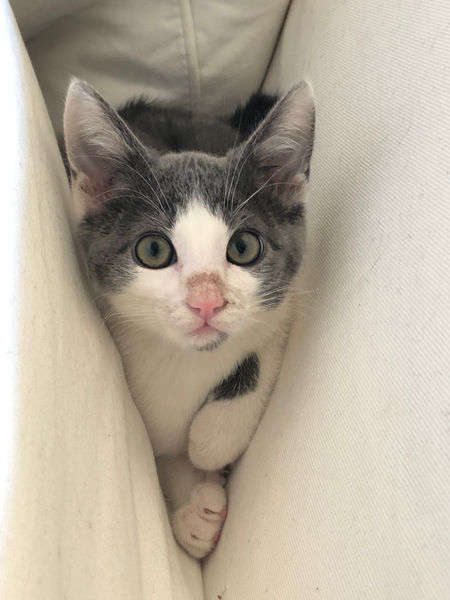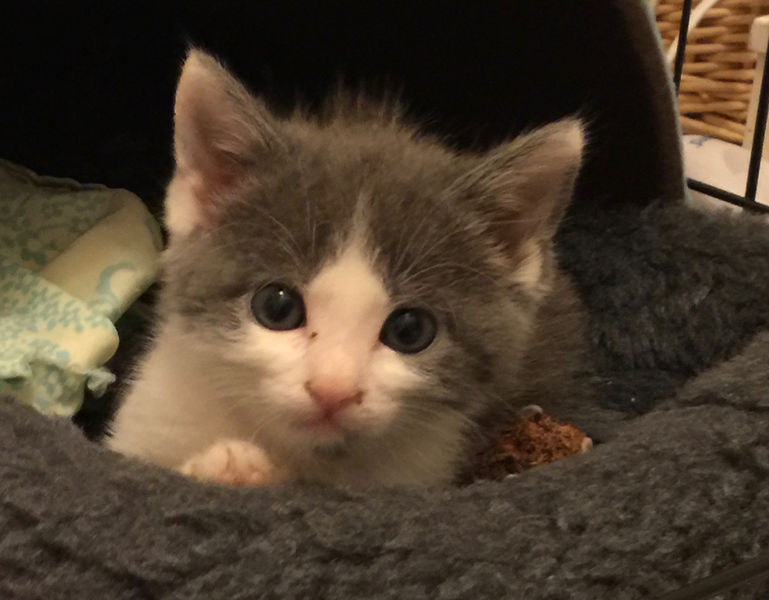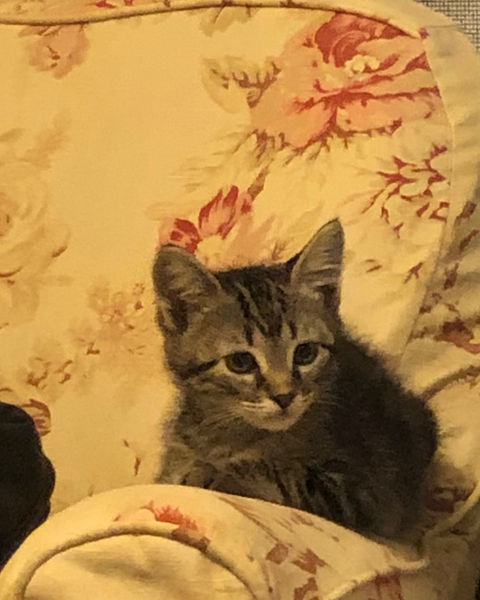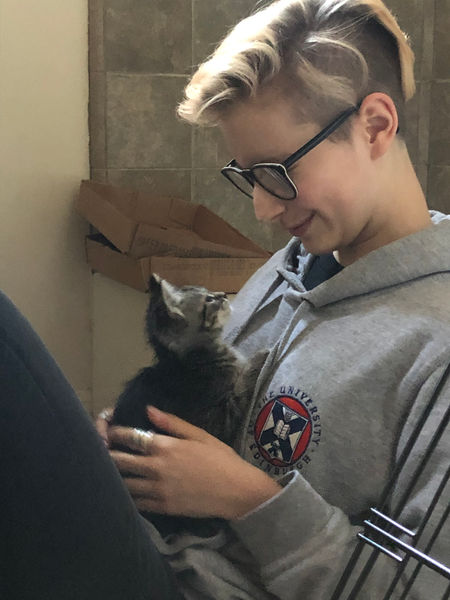KITTEN FOSTERING FOR BEST FRIENDS ANIMAL SOCIETY
About My Project
In April of 2019 I decided to start fostering Kittens with Best Friends Animal Society. I have always loved animals and I wanted to help improve the life of animals that don't have a home. On April 21st of 2019 I picked up two adorable kittens named M.A.C. and Stila. When I picked them up, they had eye and bronchial infections. As they got to know me they became more friendly, energetic, and happy kittens. Because Stila and M.AC. were four weeks old when they came to me, my job was to introduce them to kibble and wet food, teach them to use a litter box, and help them get better. The most important part of taking care of the kittens was giving them lots of attention and love. On May 15th of 2019, M.A.C. and Stila reached 2lbs and were able to go back to Best Friends just in time for the super adoption event.
On November 16th of 2019 I picked up our second group of foster kittens. Dior and Smudge were both very healthy. Dior was much larger than Smudge so he was able to go back to Best Friends two weeks after we picked him up. Smudge was much smaller and stayed with me for six weeks. I was also able to find Smudge a forever home myself. It has been really nice to be able to see pictures of my foster baby and watch as he grows up.
I also volunteered to help set up Best Friends' Strut Your Mutt event on October 16th.
A DAY IN THE LIFE
Taking care of kittens is a lot of work, but very fun and rewarding. As expected, they are very energetic and curious. Most of the time they want to play, eat, and socialize with their human care takers. I would wake up early to feed them their first meal (baby food with wet food and pro-biotics), administer any medications that they got, and weigh them to ensure they were gaining weight at a healthy speed. I would log their weight so that during check-ups and vaccines at Best Friends, any irregularity in their weight gain could be pointed out in case of illness. Throughout the day the kittens get more food whenever they finish a bowl because they need to get as much nutrients and calories as they can to grow. I would also clean their litter boxes constantly as kittens are very messy when learning to use a litter box. At night the kittens get dinner and any medications they need. Every night I would do my homework in the bathroom with the kittens in order to make sure they were getting as much socializing and play time as possible. The main goal of fostering is to prepare the kittens for adoption. At bedtime the kittens would be put back in their kennel filled with toys, a scratching tunnel, a heating pad, and kibble and water.
Because the kittens are curious, they liked the attempt to escape the bathroom. This meant that they needed to be watched carefully and barricaded in the bathroom with various baby gates and chairs until they were big enough to not hurt themselves. Gradually they were allowed to get acquainted to bigger spaces and even the other pets in the household (once they were confirmed to not have any infectious diseases). Every other week I took the kittens back to best friends for periodic checkups and shots.
Both M.A.C. and Smudge had some medical issues. M.A.C. had some bloating and Smudge had an upper respiratory infection. Both of these issues could be fatal and were very stressful as I couldn’t imagine one of my foster babies dying. Luckily with extra care, medication, and love, the kittens got better. Once they reached two pounds and eight weeks, it was time for them to go back to Best Friends to find their forever home.
WHY IS FOSTERING IMPORTANT?
In the US there are approximately 70 million stray animals and only 3-4 million get adopted a year. Only 2-5% of cats with homes are reclaimed by their owners from shelters, and about 41% of cats in shelters are euthanized nationwide. Cats are also at higher risk for euthanasia as they are less likely to be adopted than dogs.
Euthanasia is formally defined as ”the painless killing of a patient suffering from an incurable and painful disease or in an irreversible coma.” According to Katherine Sloan’s article, Death Without Dignity “In direct contrast to the very definition of euthanasia, currently, approximately 2.4 million healthy, adoptable pets are killed in shelters each year in the U.S. These animals are dying at alarming rates and, in many cases, in a state of complete agony until their bodies finally give up the will to live.”
Spay-Neuter programs are able to reduce shelter’s future intakes of homeless pets by 10%, reducing the necessity for overcrowding caused euthanasia. Cats that aren’t fixed are 330% more likely to be returned to a shelter. Early sterilization of pets also helps to reduce cancers in pets. A large reason for the amount of cats in shelters is pet adopters’ preference for animals from breeders or retail pet stores rather than the shelter.
Fostering exposes cats to humans and reduces the amount of emotional trauma they would experience in a shelter. Kittens below the age of 8 weeks are at their most vulnerable and need lots of care. With overcrowded shelters, fostering can give kittens a chance at a full and happy life. Fostering increases socialization which makes them more friendly and better candidates for adoption.
California is currently one of the worst states for unneeded euthanasia. The most recent data shows that over 100,000 animals were killed in a year. Best Friends Animal Society has a a goal to become a no-kill animal shelter by 2025 meaning that they won’t euthanise more than 10% of the animals and the one’s they do are terminally ill. (Compare to PETA shelters euthanizing nearly 97% of the animals they take in.)
Bibliography:
Sloan, Katherine. “DEATH WITHOUT DIGNITY: THE MISNOMER OF EUTHANASIA IN THE STATE ANIMAL SHELTER SYSTEM AND A CALL FOR A NO-KILL FLORIDA.” Journal of Land Use & Environmental Law, vol. 32, no. 1, 2016, pp. 261–290. JSTOR, www.jstor.org/stable/26618634.
"12 Alarming Facts About Pet Homelessness". One Green Planet, 2020, https://www.onegreenplanet.org/animalsandnature/12-alarming-facts-about-pet-homelessness/.
"Seven Reasons Why Fostering Animals Saves Lives". ASPCA, 2020, https://www.aspca.org/blog/seven-reasons-why-fostering-animals-saves-lives.
"A New Digital Tool For Saving Dogs And Cats". Best Friends Animal Society, 2020, https://bestfriends.org/2025-goal.
"What Does No-Kill Mean?". Best Friends Animal Society, 2020, https://bestfriends.org/no-kill-2025/what-does-no-kill-mean.
About Best Friends Animal Society
Best Friends' goal is to make American shelters no-kill. This means that dogs and cats that don't need to be euthanized are not being euthanized. No-kill excludes animals that can't be saved and would be suffering unnecessarily. This means that there would be around a 90% save rate of shelter animals. The other 10% are the animals entering shelters that can't be saved because they are too sick or injured. Best Friends' goal is to get America to be no-kill by 2025. In order to help cut down the overall amount of animals going into shelters, Best Friends is an advocate for spaying and neutering of pets and adopting instead of buying.
Why should you get involved and How can you get involved?
Statistics from 2017
- 733,000 dogs and cats are euthanized per year
- 15% of euthanized animals are in California (111,000)
- 16% of euthanized animals are in Texas (114,000)
For more statistics click here
- Adopt your next pet
Adoption cuts down the number of pets in shelters. It cuts down the profits that puppy mills make from the purchase of a puppy from a pet store. There are plenty of cute, lovable fluff-balls at your local shelter that would love to come home with you.
- Get your pets neutered/spayed
Getting your pet fixed won't have any negative effects on your pet's personality; it will also lower the amount of homeless pets in shelters that end up getting euthanized.
- Volunteer at Best Friends
If you live in Utah, Los Angeles, New York, or Atlanta you can volunteer at Best Friends and help them take care of all of the pets they care for. If you do not have a Best Friends facility near you, you should volunteer at your local shelter or SPCA and help them to care for their animals and prevent euthanasia.
- Foster a dog or cat
Again, if you live near a Best Friends facility and have the ability to, you should foster a cat, kitten, or dog. By fostering, you allow Best Friends to take in even more animals and save more lives. if you don't have a Best Friends, you can look into your local shelter or SPCA and see if they have a foster program. Every pet that is in a foster home gives room for more pets to be taken out of kill shelters.
- Donate supplies
Your local shelter will be very grateful for any supplies donated whether it be blankets, food, or toys for the animals. If you would like to see some toys that you could make, click here
























